2007 JEEP PATRIOT steering wheel
[x] Cancel search: steering wheelPage 261 of 440
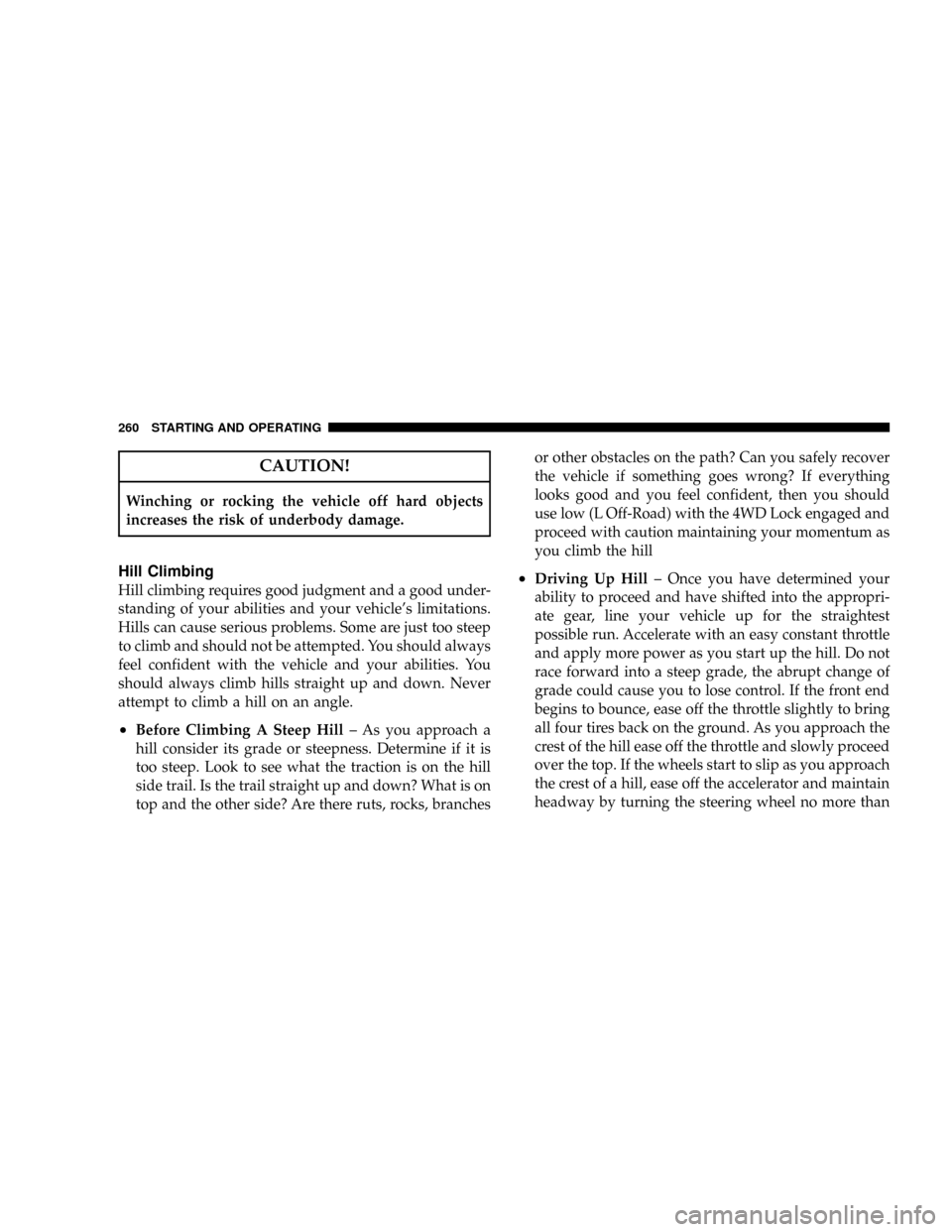
CAUTION!
Winching or rocking the vehicle off hard objects
increases the risk of underbody damage.
Hill Climbing
Hill climbing requires good judgment and a good under-
standing of your abilities and your vehicle's limitations.
Hills can cause serious problems. Some are just too steep
to climb and should not be attempted. You should always
feel confident with the vehicle and your abilities. You
should always climb hills straight up and down. Never
attempt to climb a hill on an angle.
²Before Climbing A Steep Hill± As you approach a
hill consider its grade or steepness. Determine if it is
too steep. Look to see what the traction is on the hill
side trail. Is the trail straight up and down? What is on
top and the other side? Are there ruts, rocks, branchesor other obstacles on the path? Can you safely recover
the vehicle if something goes wrong? If everything
looks good and you feel confident, then you should
use low (L Off-Road) with the 4WD Lock engaged and
proceed with caution maintaining your momentum as
you climb the hill
²Driving Up Hill± Once you have determined your
ability to proceed and have shifted into the appropri-
ate gear, line your vehicle up for the straightest
possible run. Accelerate with an easy constant throttle
and apply more power as you start up the hill. Do not
race forward into a steep grade, the abrupt change of
grade could cause you to lose control. If the front end
begins to bounce, ease off the throttle slightly to bring
all four tires back on the ground. As you approach the
crest of the hill ease off the throttle and slowly proceed
over the top. If the wheels start to slip as you approach
the crest of a hill, ease off the accelerator and maintain
headway by turning the steering wheel no more than
260 STARTING AND OPERATING
Page 268 of 440
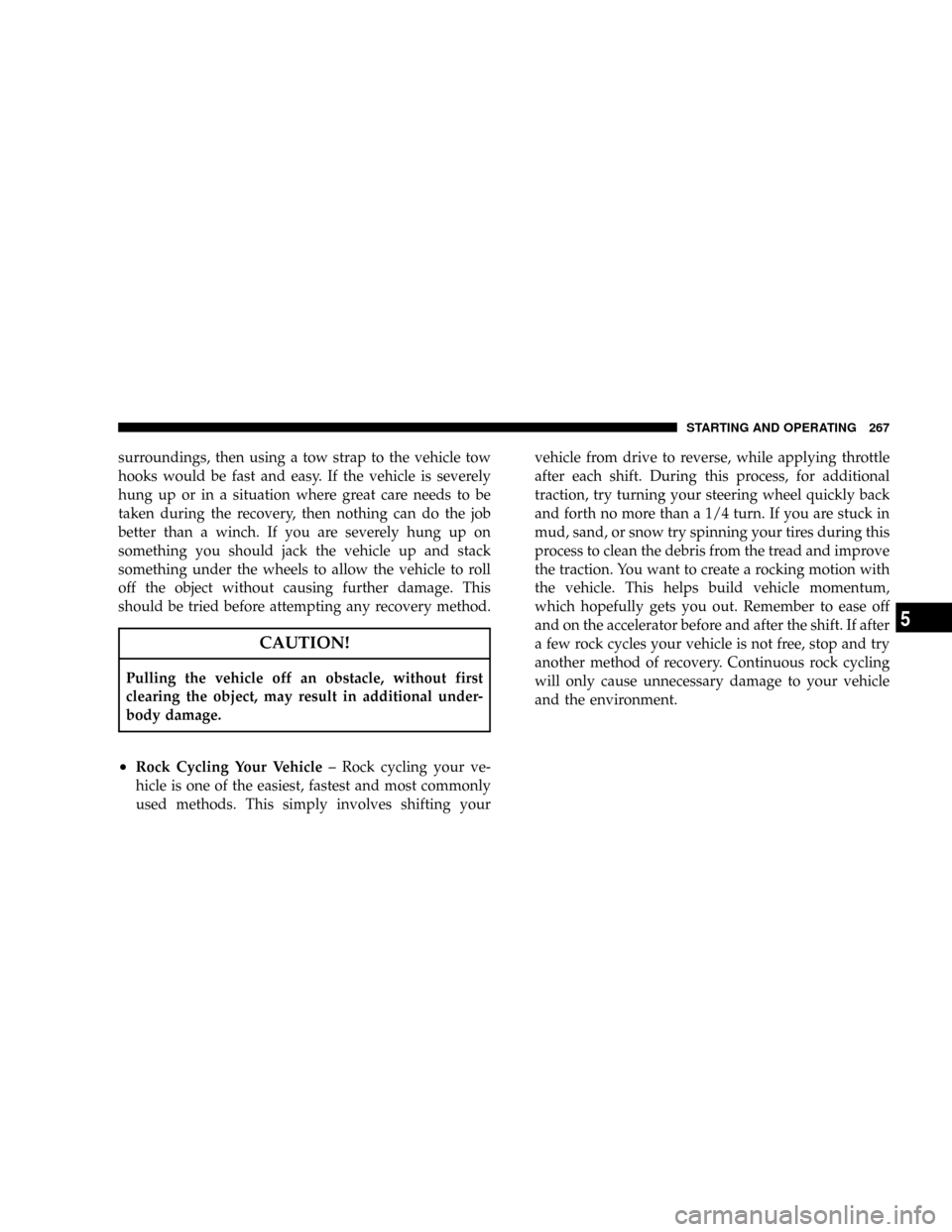
surroundings, then using a tow strap to the vehicle tow
hooks would be fast and easy. If the vehicle is severely
hung up or in a situation where great care needs to be
taken during the recovery, then nothing can do the job
better than a winch. If you are severely hung up on
something you should jack the vehicle up and stack
something under the wheels to allow the vehicle to roll
off the object without causing further damage. This
should be tried before attempting any recovery method.
CAUTION!
Pulling the vehicle off an obstacle, without first
clearing the object, may result in additional under-
body damage.
²Rock Cycling Your Vehicle± Rock cycling your ve-
hicle is one of the easiest, fastest and most commonly
used methods. This simply involves shifting yourvehicle from drive to reverse, while applying throttle
after each shift. During this process, for additional
traction, try turning your steering wheel quickly back
and forth no more than a 1/4 turn. If you are stuck in
mud, sand, or snow try spinning your tires during this
process to clean the debris from the tread and improve
the traction. You want to create a rocking motion with
the vehicle. This helps build vehicle momentum,
which hopefully gets you out. Remember to ease off
and on the accelerator before and after the shift. If after
a few rock cycles your vehicle is not free, stop and try
another method of recovery. Continuous rock cycling
will only cause unnecessary damage to your vehicle
and the environment.
STARTING AND OPERATING 267
5
Page 270 of 440
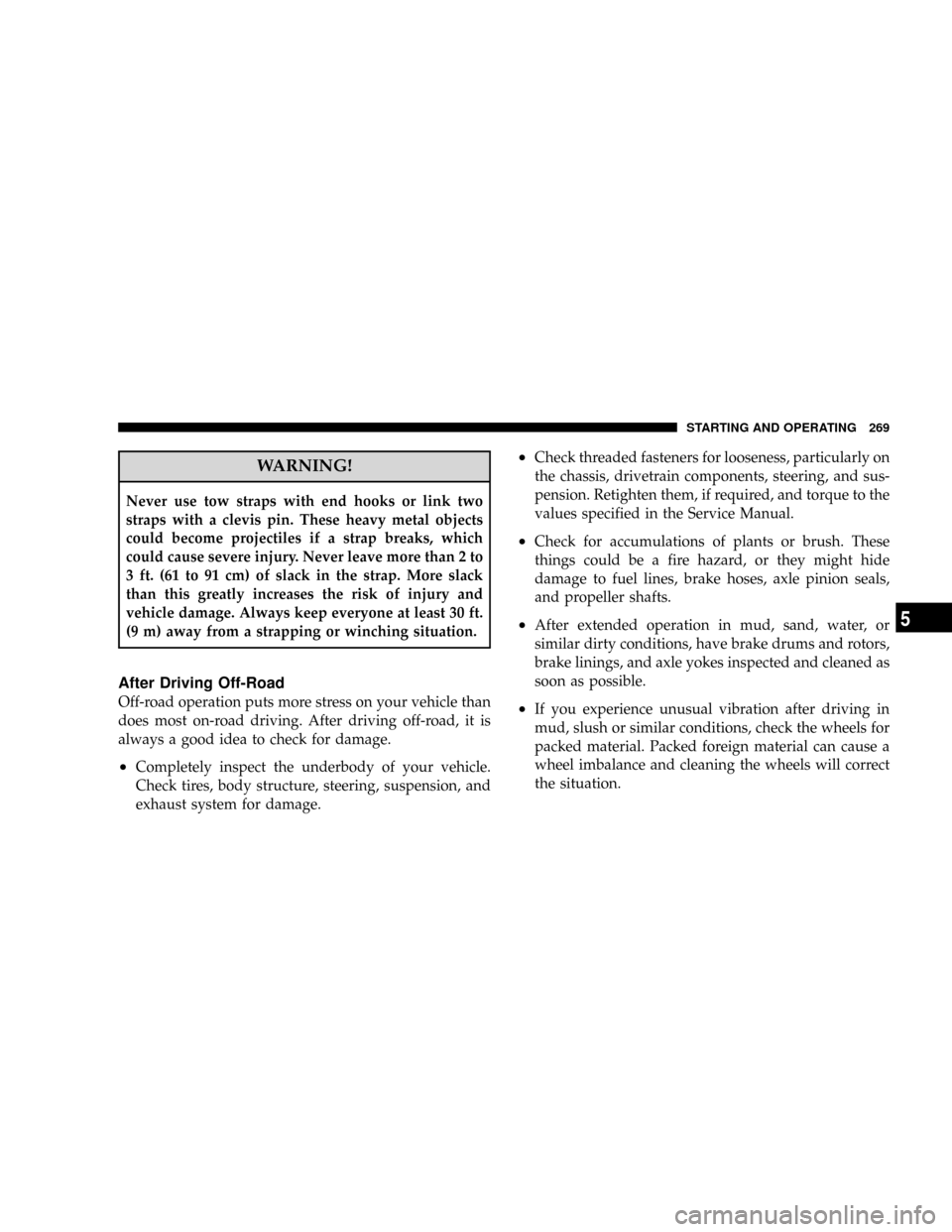
WARNING!
Never use tow straps with end hooks or link two
straps with a clevis pin. These heavy metal objects
could become projectiles if a strap breaks, which
could cause severe injury. Never leave more than 2 to
3 ft. (61 to 91 cm) of slack in the strap. More slack
than this greatly increases the risk of injury and
vehicle damage. Always keep everyone at least 30 ft.
(9 m) away from a strapping or winching situation.
After Driving Off-Road
Off-road operation puts more stress on your vehicle than
does most on-road driving. After driving off-road, it is
always a good idea to check for damage.
²Completely inspect the underbody of your vehicle.
Check tires, body structure, steering, suspension, and
exhaust system for damage.
²Check threaded fasteners for looseness, particularly on
the chassis, drivetrain components, steering, and sus-
pension. Retighten them, if required, and torque to the
values specified in the Service Manual.
²Check for accumulations of plants or brush. These
things could be a fire hazard, or they might hide
damage to fuel lines, brake hoses, axle pinion seals,
and propeller shafts.
²After extended operation in mud, sand, water, or
similar dirty conditions, have brake drums and rotors,
brake linings, and axle yokes inspected and cleaned as
soon as possible.
²If you experience unusual vibration after driving in
mud, slush or similar conditions, check the wheels for
packed material. Packed foreign material can cause a
wheel imbalance and cleaning the wheels will correct
the situation.
STARTING AND OPERATING 269
5
Page 277 of 440
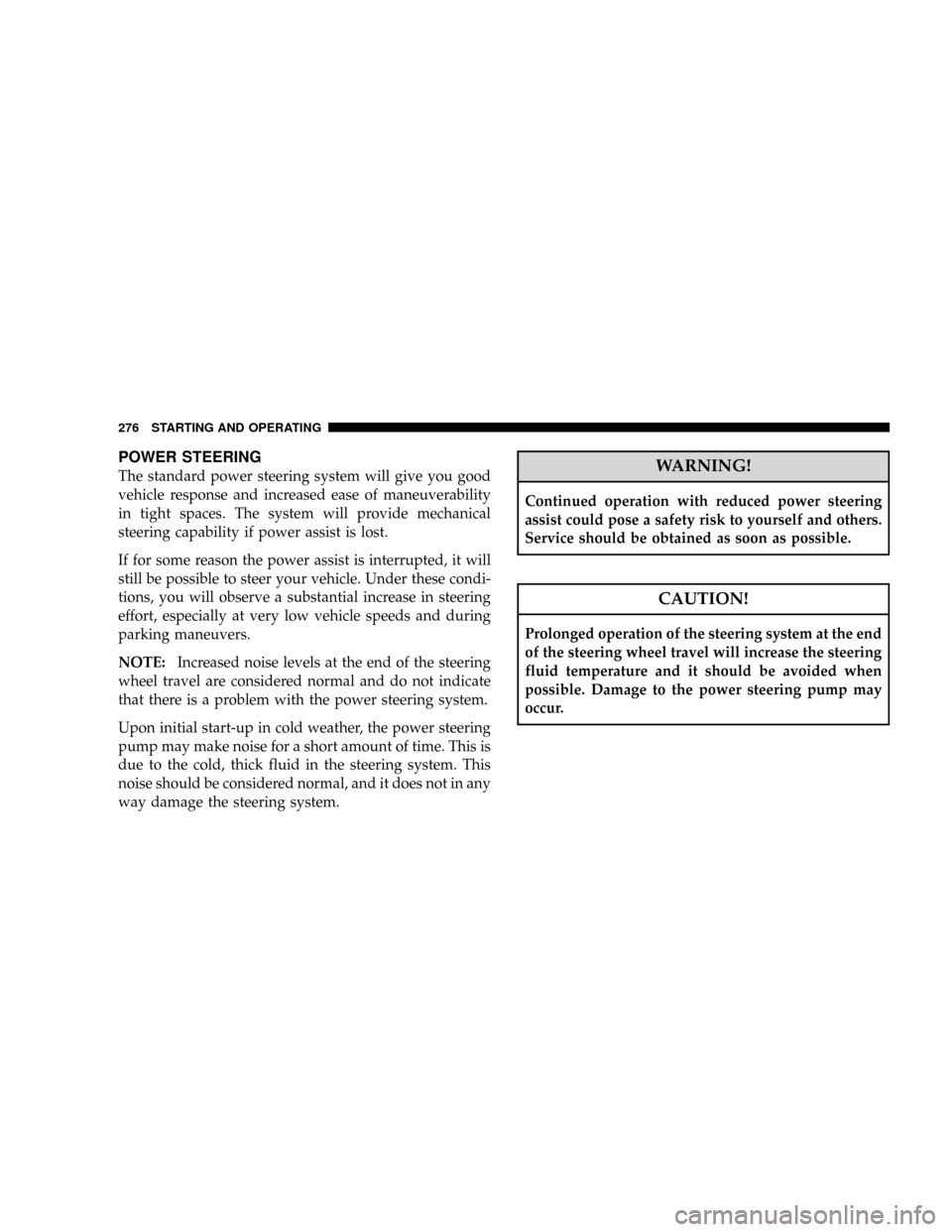
POWER STEERING
The standard power steering system will give you good
vehicle response and increased ease of maneuverability
in tight spaces. The system will provide mechanical
steering capability if power assist is lost.
If for some reason the power assist is interrupted, it will
still be possible to steer your vehicle. Under these condi-
tions, you will observe a substantial increase in steering
effort, especially at very low vehicle speeds and during
parking maneuvers.
NOTE:Increased noise levels at the end of the steering
wheel travel are considered normal and do not indicate
that there is a problem with the power steering system.
Upon initial start-up in cold weather, the power steering
pump may make noise for a short amount of time. This is
due to the cold, thick fluid in the steering system. This
noise should be considered normal, and it does not in any
way damage the steering system.WARNING!
Continued operation with reduced power steering
assist could pose a safety risk to yourself and others.
Service should be obtained as soon as possible.
CAUTION!
Prolonged operation of the steering system at the end
of the steering wheel travel will increase the steering
fluid temperature and it should be avoided when
possible. Damage to the power steering pump may
occur.
276 STARTING AND OPERATING
Page 294 of 440
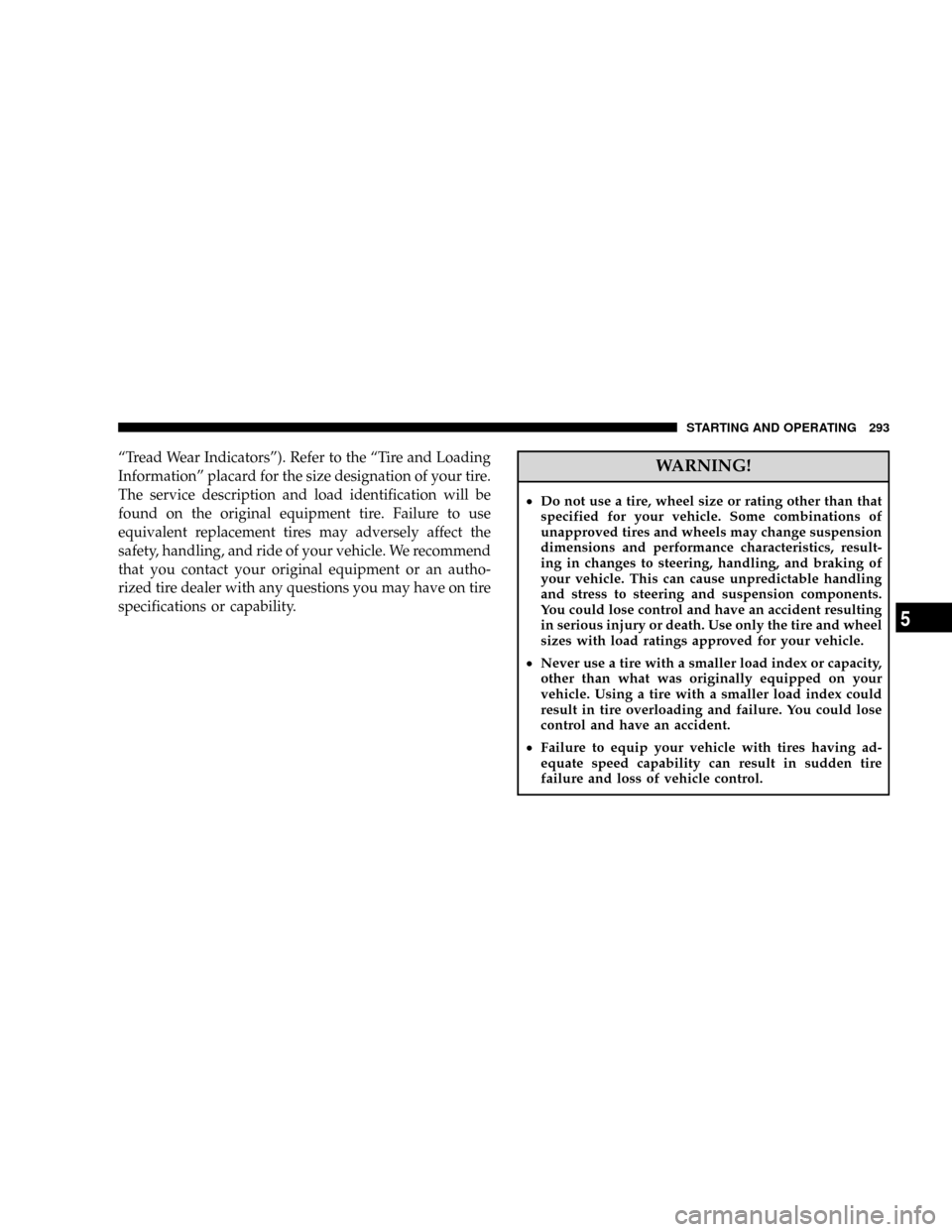
ªTread Wear Indicatorsº). Refer to the ªTire and Loading
Informationº placard for the size designation of your tire.
The service description and load identification will be
found on the original equipment tire. Failure to use
equivalent replacement tires may adversely affect the
safety, handling, and ride of your vehicle. We recommend
that you contact your original equipment or an autho-
rized tire dealer with any questions you may have on tire
specifications or capability.WARNING!
²Do not use a tire, wheel size or rating other than that
specified for your vehicle. Some combinations of
unapproved tires and wheels may change suspension
dimensions and performance characteristics, result-
ing in changes to steering, handling, and braking of
your vehicle. This can cause unpredictable handling
and stress to steering and suspension components.
You could lose control and have an accident resulting
in serious injury or death. Use only the tire and wheel
sizes with load ratings approved for your vehicle.
²Never use a tire with a smaller load index or capacity,
other than what was originally equipped on your
vehicle. Using a tire with a smaller load index could
result in tire overloading and failure. You could lose
control and have an accident.
²Failure to equip your vehicle with tires having ad-
equate speed capability can result in sudden tire
failure and loss of vehicle control.
STARTING AND OPERATING 293
5
Page 336 of 440
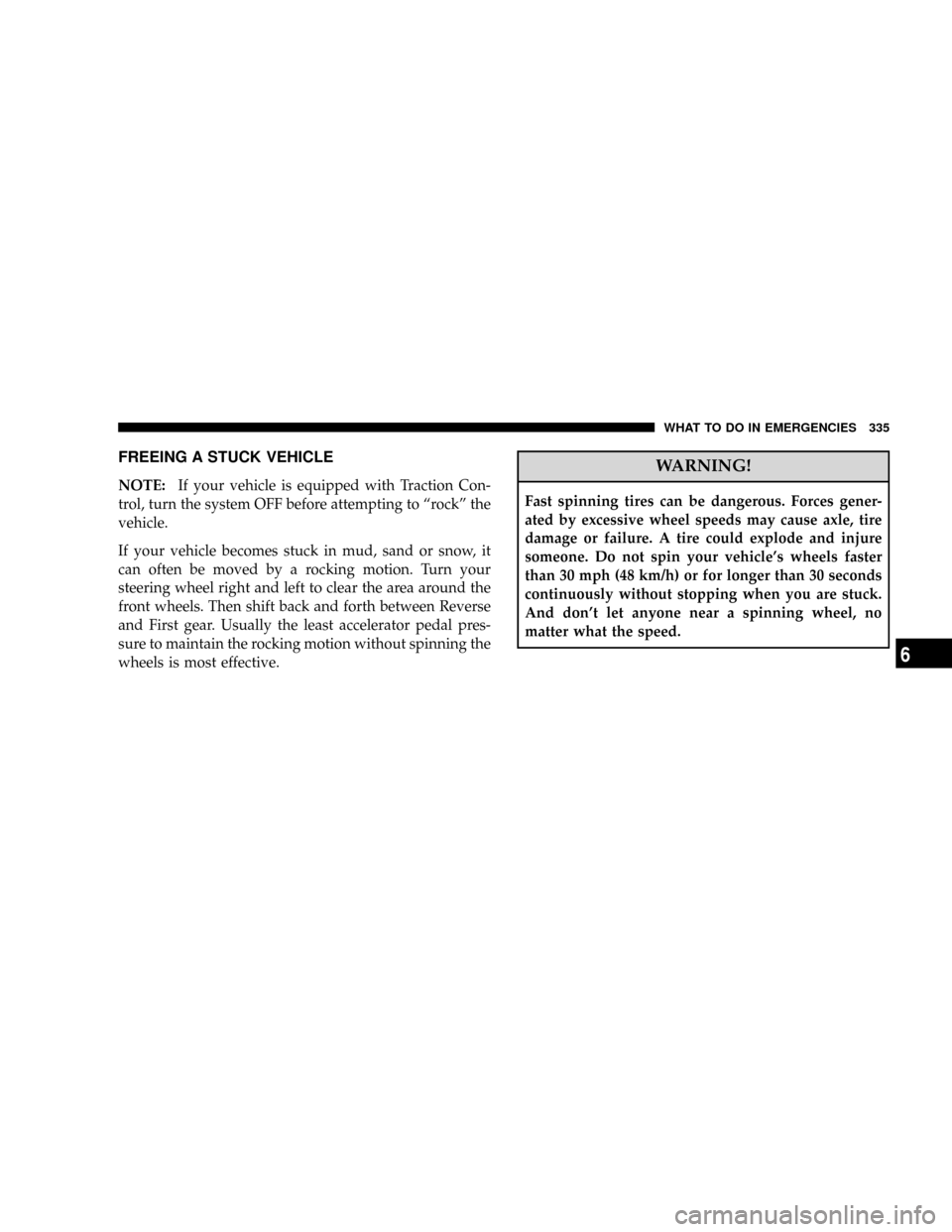
FREEING A STUCK VEHICLE
NOTE:If your vehicle is equipped with Traction Con-
trol, turn the system OFF before attempting to ªrockº the
vehicle.
If your vehicle becomes stuck in mud, sand or snow, it
can often be moved by a rocking motion. Turn your
steering wheel right and left to clear the area around the
front wheels. Then shift back and forth between Reverse
and First gear. Usually the least accelerator pedal pres-
sure to maintain the rocking motion without spinning the
wheels is most effective.
WARNING!
Fast spinning tires can be dangerous. Forces gener-
ated by excessive wheel speeds may cause axle, tire
damage or failure. A tire could explode and injure
someone. Do not spin your vehicle's wheels faster
than 30 mph (48 km/h) or for longer than 30 seconds
continuously without stopping when you are stuck.
And don't let anyone near a spinning wheel, no
matter what the speed.
WHAT TO DO IN EMERGENCIES 335
6
Page 337 of 440
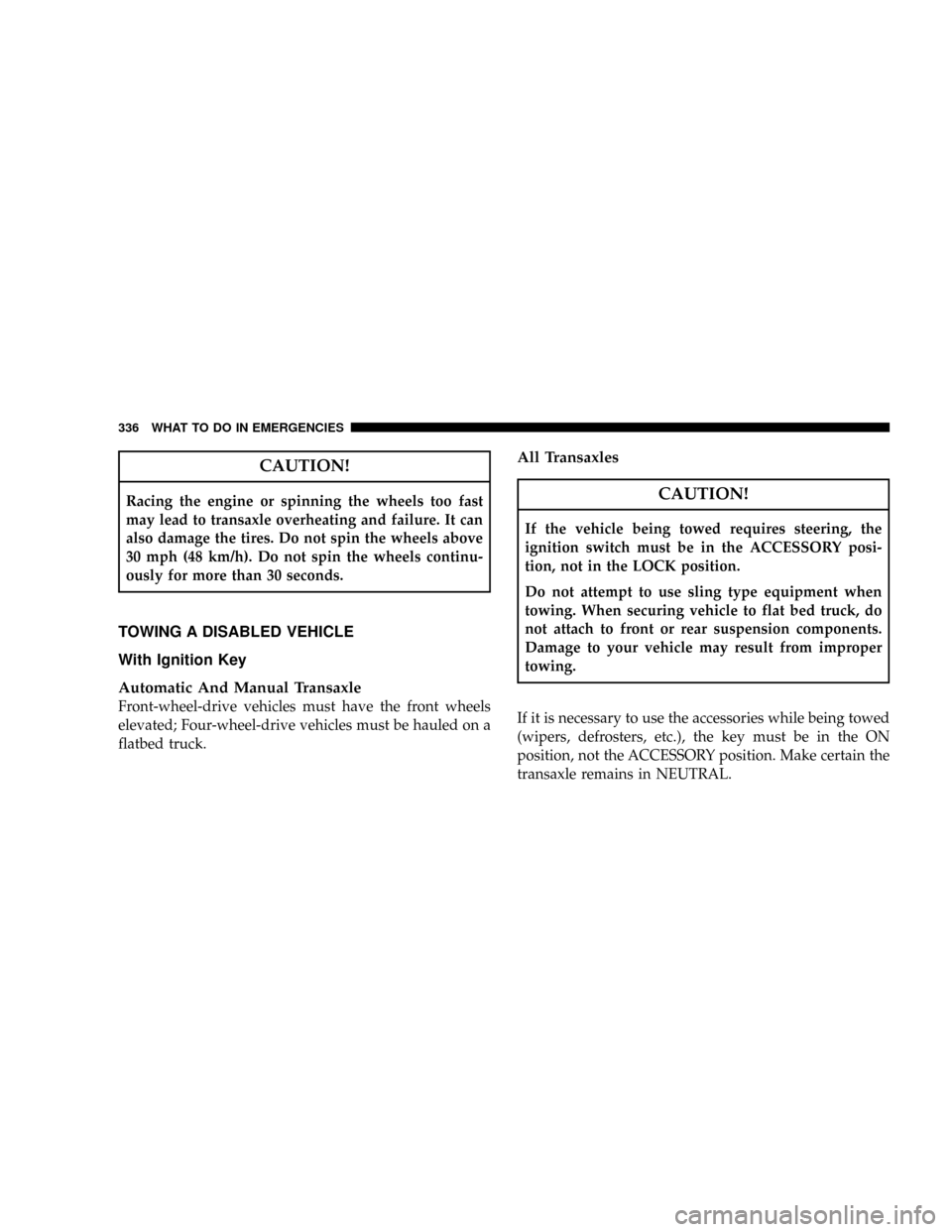
CAUTION!
Racing the engine or spinning the wheels too fast
may lead to transaxle overheating and failure. It can
also damage the tires. Do not spin the wheels above
30 mph (48 km/h). Do not spin the wheels continu-
ously for more than 30 seconds.
TOWING A DISABLED VEHICLE
With Ignition Key
Automatic And Manual Transaxle
Front-wheel-drive vehicles must have the front wheels
elevated; Four-wheel-drive vehicles must be hauled on a
flatbed truck.
All Transaxles
CAUTION!
If the vehicle being towed requires steering, the
ignition switch must be in the ACCESSORY posi-
tion, not in the LOCK position.
Do not attempt to use sling type equipment when
towing. When securing vehicle to flat bed truck, do
not attach to front or rear suspension components.
Damage to your vehicle may result from improper
towing.
If it is necessary to use the accessories while being towed
(wipers, defrosters, etc.), the key must be in the ON
position, not the ACCESSORY position. Make certain the
transaxle remains in NEUTRAL.
336 WHAT TO DO IN EMERGENCIES
Page 431 of 440
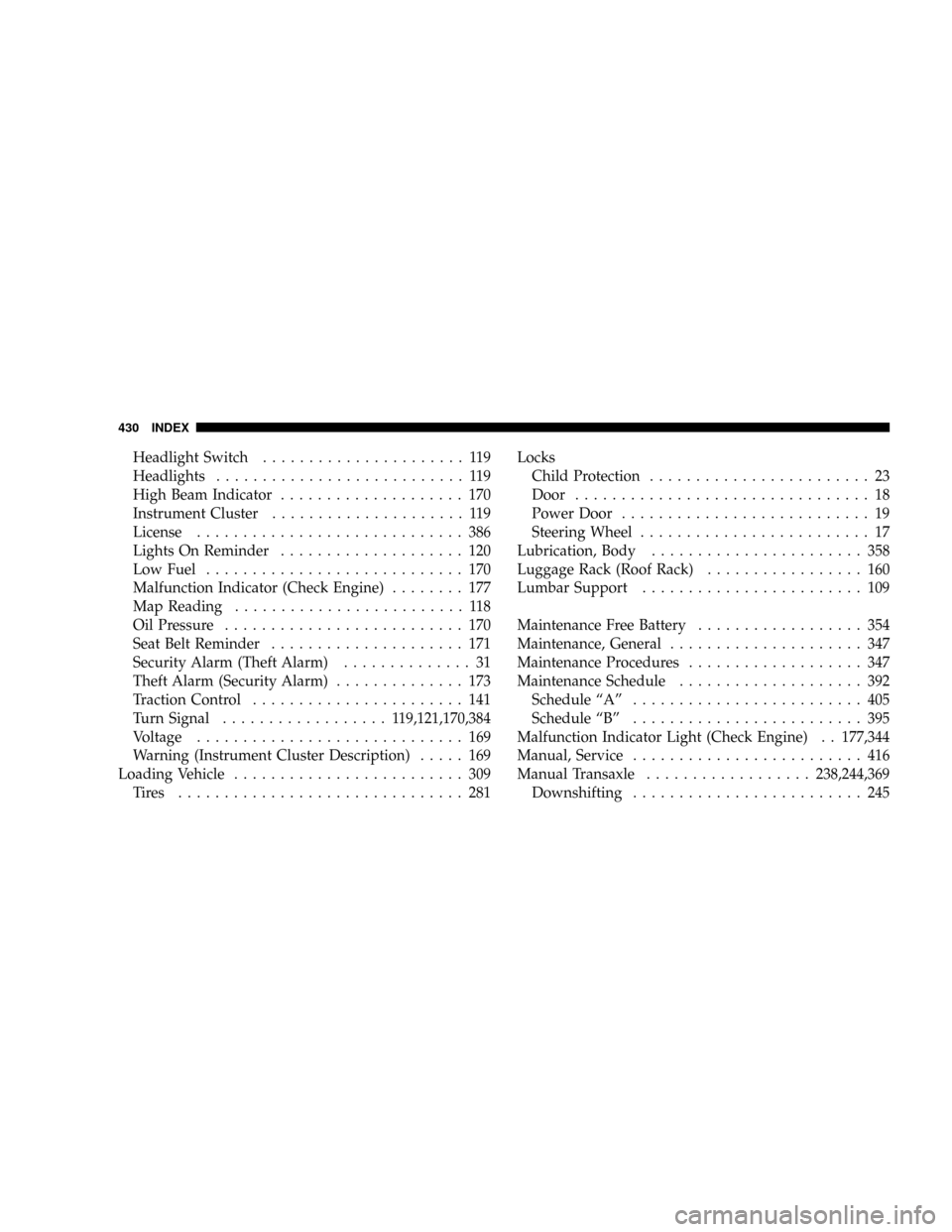
Headlight Switch...................... 119
Headlights........................... 119
High Beam Indicator.................... 170
Instrument Cluster..................... 119
License............................. 386
Lights On Reminder.................... 120
Low Fuel............................ 170
Malfunction Indicator (Check Engine)........ 177
Map Reading......................... 118
Oil Pressure.......................... 170
Seat Belt Reminder..................... 171
Security Alarm (Theft Alarm).............. 31
Theft Alarm (Security Alarm).............. 173
Traction Control....................... 141
Turn Signal.................. 119,121,170,384
Voltage............................. 169
Warning (Instrument Cluster Description)..... 169
Loading Vehicle......................... 309
Tires ............................... 281Locks
Child Protection........................ 23
Door................................ 18
Power Door........................... 19
Steering Wheel......................... 17
Lubrication, Body....................... 358
Luggage Rack (Roof Rack)................. 160
Lumbar Support........................ 109
Maintenance Free Battery.................. 354
Maintenance, General..................... 347
Maintenance Procedures................... 347
Maintenance Schedule.................... 392
Schedule ªAº......................... 405
Schedule ªBº......................... 395
Malfunction Indicator Light (Check Engine) . . 177,344
Manual, Service......................... 416
Manual Transaxle..................238,244,369
Downshifting......................... 245
430 INDEX